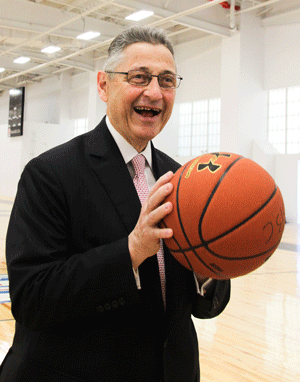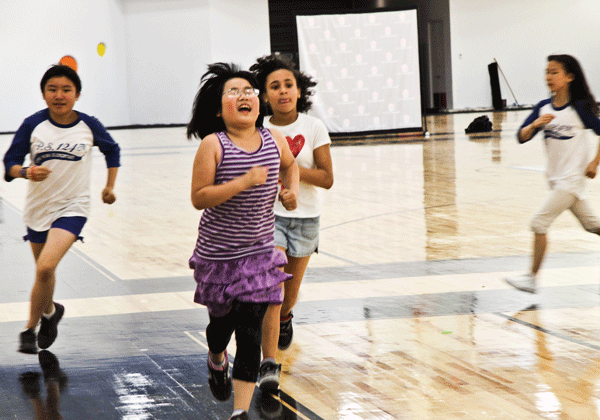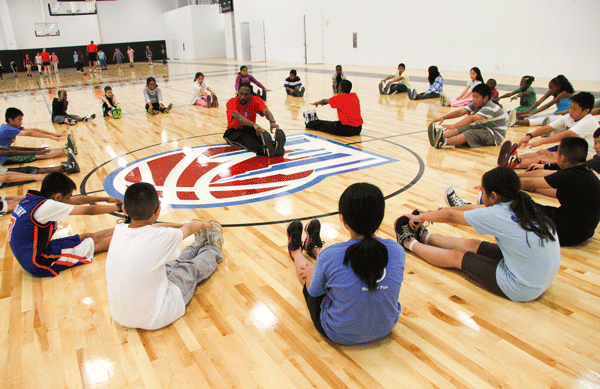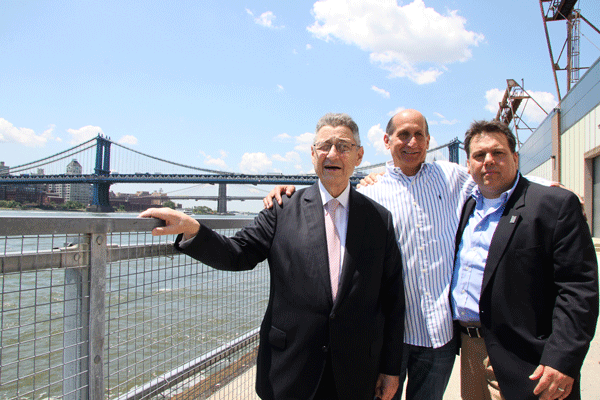 [/media-credit]
[/media-credit]
“What a wonderful sight,” he said. “I wish I had something like this when I was growing up on the Lower East Side. One of the courts I played on, the ceiling was so low, you had to shoot a line drive to score a basket.”
That won’t be a problem at the new Basketball City, which officially opened at Montgomery and South Sts. last Friday. The sports complex features six full-size basketball courts and one smaller court, and the ceiling is plenty tall enough to accommodate alley-oop passes or high-arcing 3-point shots.
The nearly 70,000-square-foot space sports a hardwood maple floor that rests atop a “green play” environmentally friendly composite surface.
Kids from three local schools — P.S. 1, P.S. 124 and P.S. 142 — were on hand to help open the facility and were raring to run onto the courts as Silver and other officials first gave remarks.
“I feel like changing into shorts and joining them — but I’ve retired from basketball,” the Assembly speaker quipped. “Our kids will be able to use these courts at little or no cost. Kids will be able to re-enact highlights of this year’s ‘Linsanity’.”
The scoreboard lights read “Sheldon” under the name for the home team and “Silver” under the visitors’ team name. It was fitting because it was Silver who put on a full-court press back in the early 1990s to ensure that the neighborhood would have access to part of Pier 36 for a community facility.
Yvonne Morrow, who formerly ran Silver’s district office, was also at the opening. Speaking before the officials gave their remarks, she recalled the long battle to win the space for the community. The city had wanted to use the cavernous pier shed — which stretches from Jackson St. nearly to Rutgers St. — for a maintenance-and-refueling facility for six municipal agencies. And where Basketball City is now — covering about one-third of the pier shed — a Department of Corrections facility for holding prisoners was planned.
Arguing too many municipal uses were being dumped on the Lower East Side waterfront and that it was thus a violation of “fair share,” the Assembly speaker filed a lawsuit — Silver v. Dinkins — against the city.

“We sued, and I argued this case in the [state] Supreme Court,” Silver said. “We won the right to preserve the waterfront space for use by our community.”
A community advisory council was next formed and worked with the Parks Department on finding uses for the space. A request for proposals (R.F.P.) was issued and Basketball City was selected.

In another score for the community, more than 75 percent of the new hoop mecca’s employees will be residents from the local community.
After his opening words, Silver introduced Bruce “Alley-Oop” Radler, Basketball City’s president, who turned around and called Silver the “Most Valuable Player.”
“We are extremely excited to finally open our new state-of-the-art facility, after a very long development process,” Radler said. “This new facility enables us to provide services to various groups — like schools, youth organizations, corporations, nonprofits — and to hold special events.”

The Assembly speaker then did a no-look pass of the mic to Councilmember Margaret “Fast Break” Chin.
“This is amazing,” Chin marveled at the massive, hangar-like space. “Did you ever imagine Pier 36 to be like this? The city was going to put a jail on this pier.” Turning to Basketball City’s president, she said, “Mr. Radler, thank you for helping us to make this dream come true so our kids can play basketball here.”
Chin added, “When it’s raining or snowing, our kids can come in here.”
Continuing the nickname trend, Silver introduced David “Triple Double” Garza, executive director of the Henry Street Settlement, which worked to ensure the facility hires locally. Basketball City isn’t just a win-win for the community, Garza said, but a “win-win-win-win.”
“Speaker Silver fought to make the whole project possible,” he recapped. “Community Board 3 and our elected officials provided the community benefit structure. Radler has done the right thing. And the community at large will benefit through local jobs, free recreational space and other activities. It’s all very exciting and the Lower East Side Employment Network looks forward to a long, productive relationship with Basketball City.”
Gigi “Game Change” Li, who is expected to be elected C.B. 3 chairperson this month, called Basketball City’s at last being opened “a long win” for the community. She said the key points are that the facility will offer jobs for the community and that court access for local residents will be at no or low cost.
After the speeches were done, Silver conducted a jump-ball tipoff between two of the schoolchildren, then pronounced, “O.K., play ball!” and the rest of the kids swarmed onto the hardwood with their athletic instructors for class.
Afterward, Radler explained that every local school — or as many as physically possible — will be able to get court time. The courts aren’t used as heavily during the day, so it’s not a problem then to have the schoolchildren there. The adult sports leagues that finance the business mainly use it at night, he said.

















